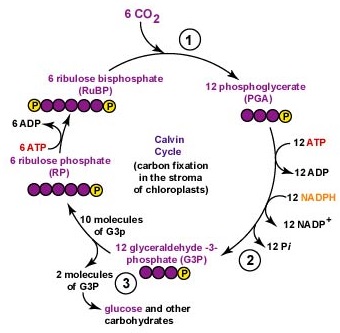18.7C: Oxygenic Photosynthesis: Light-Independent Reactions
- Page ID
- 3422
\( \newcommand{\vecs}[1]{\overset { \scriptstyle \rightharpoonup} {\mathbf{#1}} } \) \( \newcommand{\vecd}[1]{\overset{-\!-\!\rightharpoonup}{\vphantom{a}\smash {#1}}} \)\(\newcommand{\id}{\mathrm{id}}\) \( \newcommand{\Span}{\mathrm{span}}\) \( \newcommand{\kernel}{\mathrm{null}\,}\) \( \newcommand{\range}{\mathrm{range}\,}\) \( \newcommand{\RealPart}{\mathrm{Re}}\) \( \newcommand{\ImaginaryPart}{\mathrm{Im}}\) \( \newcommand{\Argument}{\mathrm{Arg}}\) \( \newcommand{\norm}[1]{\| #1 \|}\) \( \newcommand{\inner}[2]{\langle #1, #2 \rangle}\) \( \newcommand{\Span}{\mathrm{span}}\) \(\newcommand{\id}{\mathrm{id}}\) \( \newcommand{\Span}{\mathrm{span}}\) \( \newcommand{\kernel}{\mathrm{null}\,}\) \( \newcommand{\range}{\mathrm{range}\,}\) \( \newcommand{\RealPart}{\mathrm{Re}}\) \( \newcommand{\ImaginaryPart}{\mathrm{Im}}\) \( \newcommand{\Argument}{\mathrm{Arg}}\) \( \newcommand{\norm}[1]{\| #1 \|}\) \( \newcommand{\inner}[2]{\langle #1, #2 \rangle}\) \( \newcommand{\Span}{\mathrm{span}}\)\(\newcommand{\AA}{\unicode[.8,0]{x212B}}\)
Briefly describe the overall function of the light-independent reactions in photosynthesis and state where in the chloroplast they occur. State how the light-dependent and light-independent reactions are linked during photosynthesis. State the reactants and the products for the light-independent reactions. Briefly describe the following stages of the Calvin cycle: - CO2 fixation
- production of G3P
- regeneration of RuBP
State the significance of glyceraldehyde-3-phosphate (G3P) in the Calvin cycle.
- CO2 fixation
- production of G3P
- regeneration of RuBP

Summary
- Photoautotrophs absorb and convert light energy into the stored energy of chemical bonds in organic molecules through a process called photosynthesis.
- Plants, algae, and cyanobacteria are known as oxygenic photoautotrophs because they synthesize organic molecules from inorganic materials, convert light energy into chemical energy, use water as an electron source, and generate oxygen as an end product of photosynthesis.
- Oxygenic photosynthesis is composed of two stages: the light-dependent reactions and the light-independent reactions.
- The light-independent reactions use the ATP and NADPH from the light-dependent reactions to reduce carbon dioxide and convert the energy to the chemical bond energy in carbohydrates such as glucose.
- The light-independent reactions can be summarized as follows: 12 NADPH + 18 ATP + 6 CO2 yields C6H12O6 (glucose) + 12 NADP+ + 18 ADP + 18 Pi + 6 H2O.
- Most plants use the Calvin cycle to fix CO2. To begin the Calvin cycle, a molecule of CO2 reacts with a five-carbon compound called ribulose bisphosphate (RuBP) producing an unstable six-carbon intermediate which immediately breaks down into two molecules of the three-carbon compound phosphoglycerate (PGA).
- The energy from ATP and the reducing power of NADPH (both produced during the light-dependent reactions) is now used to convert the molecules of PGA to glyceraldehyde-3-phosphate (G3P), another three-carbon compound.
- Most of the G3P produced during the Calvin cycle are used to regenerate the RuBP so that the cycle may continue, however, some of the molecules of G3P, however, are used to synthesize glucose and other organic molecules.


